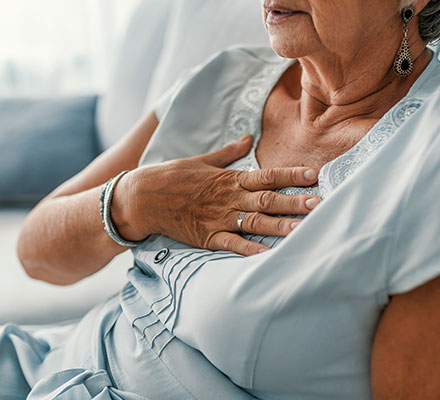


Cardiovascular disease (CVD) is the leading cause of death in the United States, accounting for approximately 500,000 deaths each year. More women in the United States die of heart disease than of any other cause, and one form of heart disease, myocardial infarction, is responsible for the majority of these deaths. In every year since 1984 it has claimed the lives of more women than men. The mortality rate for women following a heart attack is 8% in the first month; more than 2-5 times higher than men. Moreover, women who survive myocardial infarction are at high risk for repeated heart attacks and heart failure.
Women are more likely to have diabetes mellitus, congestive heart failure (CHF), and hypertension prior to myocardial infarction (MI) compared with men. Women also experience differences in pathophysiology of myocardial infarction, access to treatment, and response to treatment.
Pathophysiology
An acute myocardial infarction is caused by a sudden blockage of the coronary artery, responsible for feeding the heart muscle with oxygen. The blockage is typically caused by a plaque of cholesterol freeing from the atery wall and occluding the artery. Without oxygen the muscle becomes acutely injured and the patient experiences a myocardial infarction or heart attack. The objective of treatment, then, is either to open the vessel, or make the blood thin enough to pass around the occlusion.
Treatment
Several treatments are available for an acute myocardial infarction, the most notable of which are tPA, a powerful blood-thinning agent, and PTCA or “angioplasty,” an intervention using a guide wire and a balloon to open the closed artery. Both interventions are time-sensitive; the longer the delay, the worse the long-term heart function and the higher the mortality. These treatments should be delivered within 2 hours for maximum efficacy.
The introduction of thrombolytic therapy, the most commonly employed method of reperfusion for the treatment of an acute MI, has resulted in a 25% to 35% reduction in short-term mortality. Unfortunately, women presenting with an acute MI are at greater risk of dying or developing complications. such as intracerebral bleeding, from treatment with thrombolytic therapy.
One large clinical trial, revealed women wait significantly longer to receive life-saving therapy. They don’t receive tPA as often as men, they don’t respond as well, and they have a 15% higher mortality following an MI. Women also had more complications including shock, CHF , serious bleeding, and reocclusion and they have more complicating factors such as hypertension, diabetes and smoking. They also delay their own care, waiting 12 hours or more in 20% of cases.
Delays in seeking care and receiving treatment may be explained by different symptoms in women. In one study, women had less chest pain than men, presenting instead with jaw pain, neck pain, back pain, shortness of breath and nausea, with 25% experiencing no chest pain whatsoever. Many had no diaphoresis or cold sweats, a classic hallmark of myocardial infarction. Their EKG’s often didn’t show definitive evidence of heart problems.
Women are more likely to go to their primary care provider, who is less likely to be aggressive with treatment and testing. They also receive aspirin and beta blockers less often than men after myocardial infarction.
Direct angioplasty (PTCA) is commonly used as an alternative to thrombolytic therapy for treatment of an acute MI. Benefits from PTCA include lower early mortality, fewer strokes, reinfarction, or recurrent ischemia, and shorter hospital stays. But data from the national hospital discharge survey show that women are half as likely to receive invasive cardiac procedures as men, despite having greater functional disability from angina.
Medical/Legal Concerns
Both patients and health care providers should be educated about atypical symptoms and possible gender differences in presenting characteristics of myocardial infarction.
Delay in definitive treatment substantially increases both mortality and long-term heart function. Physicians should treat acute infarctions aggressively with either tPA or PTCA. In institutions where PTCA is readily available, women with a severe MI should be referred for direct PTCA, because they have higher complications with tPA.
“Lack of significant chest pain may be a major reason why women have more unrecognized heart attacks than men or are mistakenly diagnosed and discharged from emergency departments,” said Dr. McSweeney, author of a large study examining MI symptoms in women “Many clinicians still consider chest pain as the primary symptom of a heart attack.” The investigators reported that 43% of the women had no pain with acute infarction; instead, these women often described chest aching, chest tightness, or chest pressure, experiencing it primarily in the back and high chest. Other acute symptoms were shortness of breath in 58%, weakness in 55%, unusual fatigue in 43%, cold sweat in 39%, and dizziness in 39%.
Not only do physicians miss the warning signs and symptoms of heart attacks in women, but women typically ignored their own warning symptoms. Warning symptoms occurred in 95% of women, including unusual fatigue in 70%, sleep disturbance in 48%, shortness of breath in 42%, indigestion in 39%, and anxiety in 35%. Only 30% of women reported chest discomfort as a warning symptom, and they described it as aching, tightness, or pressure rather than as pain.
Women need to seek medical care to determine the cause of suspicious symptoms, especially if they have known cardiovascular risks such as smoking, high blood pressure, high cholesterol, diabetes, obesity or a family history of heart disease. Physicians need to be aware of the differences in presentation between men and women.
Physicians should take care to review the warning symptoms and signs of women presenting with atypical pain, pressure, shortness of breath, dizziness or unusual fatigue, and should have a very low threshold for further diagnostic testing. Women at higher risk who have known significant family history or other complicating medical diseases should undergo routine testing for coronary blockage similar to their male counterparts. Physicians should not hesitate to perform or refer patients to invasive diagnostic procedures because they assume the patients’ risk for heart attacks are lessened or because the symptoms and signs are atypical. They should be aggressive about utilizing pharmalogical therapy in their patients with known disease to prevent further incidents.
A heightened awareness and aggressive approach by both the patient and the clinician will hopefully reduce the high mortality of this deadly and often overlooked disease in women.
The medical expert witness partner for attorneys serious about building a winning case
AMFS is your trusted source for highly-qualified medical expert witnesses. After pioneering the field nearly three decades ago, we’re continuing to redefine medical expert witness services by providing value far beyond a referral alone.
Our Physician Medical Directors know what it takes to build a strong case. Our medical expert witnesses leave no doubt. And our case managers streamline billing and logistics every step of the way, letting you focus on what you do best: constructing your winning case. Explore why AMFS clients expect more from their medical expert witnesses—and get it.
